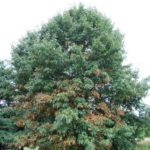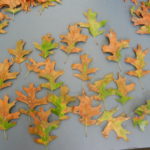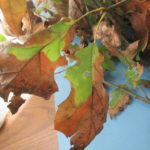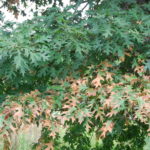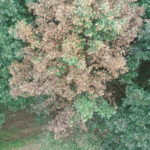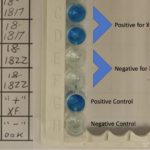Bacterial leaf scorch (BLS) on oak is a systemic disease caused by the bacterium Xylella fastidiosa (Xf) (Fig 1). The bacteria live in the xylem vessels (water conducting elements) and restrict water flow. Xf is transmitted from tree to tree by xylem-feeding insects such as leafhoppers and treehoppers. Numerous woody hosts are susceptible to various strains of Xf .
Symptoms of bacterial leaf scorch may vary somewhat between oak species. On pin oaks, scorching appears along the leaf margins and progresses inward toward the mid-vein (Fig 2). There is often a yellowish margin between the scorched leaf tissue and green tissue. On other red oaks, the scorch typically appears at the leaf tip and progresses up the leaf towards the petiole (Fig 3). Branches with leaves that appear to be healthy may be interspersed on the same tree amidst branches with scorched, diseased leaves (Fig 4).
- Fig. 2. Pin oak leaves that tested positive for Xf
- Fig. 3. Bacterial leaf scorch symptom on red oak
- Fig. 4. Healthy appearing branches on same tree with scorched branches
Leaf scorch and premature leaf drop caused by Xf are similar to symptoms that can be caused by Oak wilt (BP-28-W) and Tubakia (PLR article). Root-related stress factors can also cause marginal scorch similar in appearance to symptoms caused by bacterial leaf scorch.
The timing of bacterial leaf scorch symptoms can also present a diagnostic challenge. Infected trees often appear healthy until mid-summer. Initial symptoms usually begin as a few scorched leaves sometime in mid-to-late August, but the scorching expands rapidly to involve other leaves in September and October (Fig 5). The challenge is that the symptoms can be easily mistaken for physiological leaf scorch or early fall color.
The only way to confirm a diagnosis of bacterial leaf scorch is through laboratory analysis.
The PPDL uses a specialized serological ELISA assay to detect the presence of the bacteria in infected petioles and midribs from symptomatic leaves. (Fig 6)
Antibiotic injections can be used for high value specimen trees to suppress symptoms but there is no cure for bacterial leaf scorch which is why they are not recommended. One should expect diseased trees to gradually decline over time. It may take from 5 to 10 years until trees infected with Xf exhibit dieback and branches that need to be removed. It is suggested that tree owners provide optimal growing conditions for infected trees to prolong their survival and begin to plant replacement trees that will attain a reasonable size before the diseased ones need to be removed. A publication from University of Kentucky has a list of susceptible trees and a list of trees in which bacterial scorch has not yet been found.
Insecticides are currently not recommended to control the insects that vector this disease.
